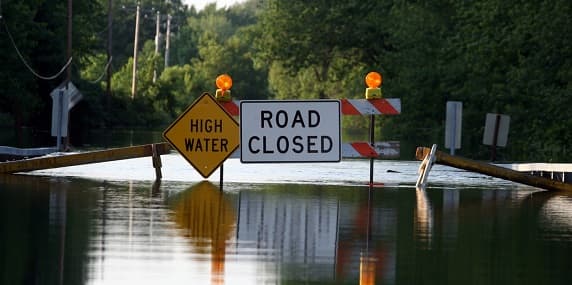Newsroom
Supporting British Columbians through flooding
May 04, 2023

With recent flood warnings and advisories issued in our province, we're sharing important information for British Columbians on insurance, safety tips, and essential documents and items to pack in case of emergency.
We urge British Columbians to plan for the unexpected and stay away from flood water as much as possible. Flooded rivers and streams are unpredictable, and flood water can carry toxic chemicals.
For up-to-date information about areas under evacuation orders, please see the River Forecast Centre.
If your vehicle is damaged by flooding, we'll do everything we can to help. You can report a claim online or by phone (1-800-910-4222) at any time.
Be prepared
If you're preparing for possible flooding or on evacuation alert, it's a good idea to locate and pack important documents in a waterproof bag or container to avoid losing them or having to replace them if they get damaged. These documents may include:
Identification such as your B.C. driver's licence, B.C. identification card, B.C. Services Card, passport, and original copies of your birth certificate, marriage certificate, and Canadian citizenship documentation.
A copy of your vehicle registration, licence and Autoplan insurance documents.
Other documents such as a copy of your home insurance policy and banking/financial information—or anything you may not be able to access remotely or online.
It's also important to have a “grab-and-go" kit ready with important items such as medication, food, batteries, etc. in case you need to leave immediately.
If any of your vehicles, including motor homes, trailers or snowmobiles, are parked in low-lying areas that may be subject to flooding, find a safe location on high ground to park them. If your vehicle is uninsured or unlicensed, you can purchase a temporary operating permit with coverage that includes basic insurance from any Autoplan broker to operate it on the road.
Driving tips
It's important to stay away from floodwater, including walking or driving, as much as possible. Flooded rivers and streams are unpredictable – they can carry debris and toxic chemicals, and quickly destroy roads, bridges and cause landslides.
Avoid driving in evacuation areas, be prepared and plan an alternate route in case the road you want to use is closed. Check DriveBC.ca before travelling for the latest road conditions and EmergencyInfoBC.ca for information about areas under evacuation alerts and orders.
If you find yourself on a road that's flooded, the best choice is to turn around if you can do so safely. If a road is marked as closed, do not continue.
Floodwater can quickly sweep away vehicles. Depending on the size of your vehicle, 15 centimetres of water can cause loss of control and possible stalling and damage to the mechanical and electrical components of your vehicle. Even at smaller depths, water can splash up and damage your undercarriage. Thirty centimetres or a foot of water will float many vehicles.
Water can also hide dips and potholes in the road as well as submerged trees or downed power lines. Without being able to see the road's surface, you may hit something and cause major damage to your vehicle (on top of possible flood damage).
If you absolutely must drive through flooded roads to get to safety, try to calculate the water depth, any potential hazards below and anticipate how your vehicle may respond. Be extra cautious when driving at night because it will be more difficult to spot hazards. If your vehicle stalls, be prepared to abandon it and move safely to higher ground.
If water has entered your vehicle, don't attempt to start it as that can cause more damage (and any resulting damage may not be covered by your insurance). Get your vehicle towed to a qualified professional to ensure it's safe to operate.
If you made it through a flooded road and your engine is still running, your vehicle should still be checked by a qualified professional as soon as possible.
If your vehicle is damaged, we'll do everything we can to help. You can report a claim online or by phone (1-800-910-4222) at any time.
Insurance coverage
We recommend collision and comprehensive or specified perils for all our customers, especially those who live in areas that are susceptible to flooding. You can renew your policy up to 44 days before it expires. If you don't have this coverage, you may purchase it from an Autoplan broker before a River Forecast Centre flood warning.
If your vehicle is damaged by flooding or landslides while parked, it would typically be covered under comprehensive insurance coverage. If you had to drive into and through a body of water, it would typically be covered under collision coverage.
In any situation, you can rest assured that we will do everything we can to support and help you access your coverages to repair or replace your vehicle in the event of a flood.
You will not be able to purchase new comprehensive or specified perils insurance if any of the following apply to your vehicle:
It is uninsured or unlicensed
There is a River Forecast Centre flood warning that applies to your vehicle's location
You've been ordered to evacuate or placed on evacuation alert
You can still buy basic and collision coverages or a temporary operating permit with basic coverage to move your vehicle to safety.
Once the vehicle has been removed from the designated warning, alert or evacuation zone, or once those zones are no longer active, you can purchase comprehensive or specified perils coverage.
For more information about insurance coverage and restrictions for residents in affected areas, please contact your Autoplan broker.
